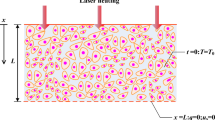Abstract
Thermal relaxation times were introduced into modern skin-laser science with the inception of selective photothermolysis. As a result, laser pulsewidths were determined according to the thermal relaxation times of the tissue targets. The Arrhenius Damage Integral shows that this approach is incorrect. The important parameter is the time required to induce irreversible protein denaturation within the target. This time is determined by the tissue’s intrinsic structure, not its physical dimensions. This report explains why thermal relaxation times should not be considered when treating many skin conditions with lasers or IPL systems.


Similar content being viewed by others
References
Anderson RR, Parrish JA (1981) Microvasculature can be selectively damaged using dye laser: a basic theory and experimental evidence in human skin. Lasers Surg Med 1(3):263–76
Anderson RR, Parrish JA (1983) Selective photothermolysis: precise microsurgery by selective absorption of pulsed radiation. Science 220:524–527
Altshuler GB, Anderson RR, Manstein D, Zenzie HH, Smirnov MZ (2001) Extended theory of selective photothermolysis. Lasers Surg Med 29:416–432
Mark W. Dewhirst, DVM, PhD, Ellen Jones, MD, PhD, Thaddeus Samulski, PhD, Zeljko Vujaskovic, MD, PhD, Chuan Li, PhD, and Leonard Prosnitz, MD. (2003) The Biology of Hyperthermia, Holland-Frei Cancer Medicine, 6th Edition
Henriques FC, Moritz AR (1947) Studies of thermal injury, 1. The conduction of heat to and through skin and the temperature attained therein. A theoretical and an experimental investigation. A J Pathol 23:531–549
Moritz AR, Henriques FC (1947) Studies of thermal injury, 2. The relative importance of time and surface temperature in the causation of cutaneous burns. A J Pathol 23:695–720
Diller KR, Pearce JA (1999) Issues in modelling thermal alterations in tissues. Ann NY Acad Sci 888:153–164
Parlette EC, Groff WF, Kinshella MJ, Domankevitz Y, O’Neill J, Ross EV (2006) Optimal pulse durations for the treatment of leg telangiectasias with a neodymium YAG laser. Lasers Surg Med 38(2):98–105
Thomsen S, Peare JA (2011) Thermal damage and rate processes of biological tissues. In Welch AJ, van Gemert MJC (editors). Optical-thermal response of laser-irradiated tissue, 2nd ed, Chapter 13, page 535).
Agah R (1994) John A Pearce, Ashley J Welch, Massoud Motamedi. Rate process model for arterial tissue thermal damage: Implications on vessel coagulation. Lasers Surg Med 15(2):176–184
Majaron B, Nelson JS. Laser treatment of Port Wine Stains. In Welch AJ, van Gemert MJC (editors). Optical-thermal response of laser-irradiated tissue, 2nd ed, Chapter 23, page 879).
Selim MM, Kelly KM, Nelson JS et al (2004) Confocal microscopy study of nerves and blood vessels in untreated and treated port wine stains: preliminary observations. Dermatol Surg 30(6):892–897
Lanigan SW (1998) Port-wine stains unresponsive to pulsed dye laser: explanations and solutions. Br J Dermatol 139:173–177
Michael Drosner et. al. (2008) Comparison of intense pulsed light (IPL) and pulsed dye laser (PDL) in port-wine stain treatment Medical Laser Application 23 (3): 133–140. (http://www.sciencedirect.com/science/article/pii/S161516150800046X)
Babilas P. et.al. (2010) Split-face comparison of intense pulsed light with short- and long-pulsed dye lasers for the treatment of port-wine stains. Lasers Surg. Med. 42(8): 720–7. http://www.ncbi.nlm.nih.gov/pubmed/20886506
Behrooz Barikbin, Azin Ayatollahi, Somayeh Hejazi, Zahra Saffarian, Sara Zamani. (2011) The Use of Intense Pulsed Light (IPL) for the Treatment of Vascular Lesions, Journal of Lasers in Medical Sciences, 2: 2, Spring
Author information
Authors and Affiliations
Corresponding author
Rights and permissions
About this article
Cite this article
Murphy, M.J., Torstensson, P.A. Thermal relaxation times: an outdated concept in photothermal treatments. Lasers Med Sci 29, 973–978 (2014). https://doi.org/10.1007/s10103-013-1445-8
Received:
Accepted:
Published:
Issue Date:
DOI: https://doi.org/10.1007/s10103-013-1445-8




